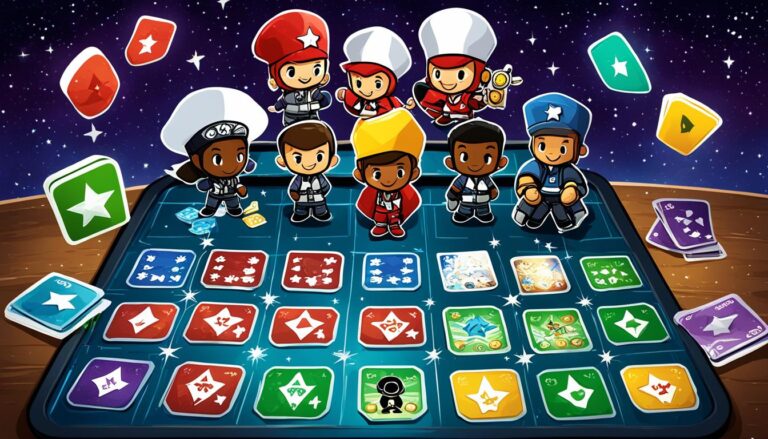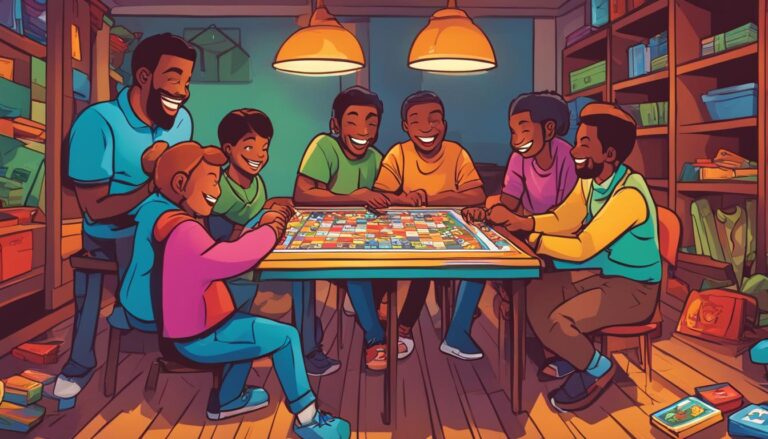Disclosure: This Post Contains Affiliate Links; We earn a commission on purchases.
Welcome to the world of Hanabi, a captivating cooperative card game that will put your memory, teamwork, and strategic skills to the test. Designed by renowned game designer Antoine Bauza and published by R & R Games, Hanabi offers a unique and immersive gaming experience like no other.
In Hanabi, players must work together towards a common goal: achieving the highest possible score. The twist? You can see everyone else’s cards, but not your own. This means effective communication, trust, and collaboration are essential for success. Can you and your fellow players master the art of cooperation to create stunning card combinations and outshine even the most challenging puzzles?
Key Takeaways:
- Hanabi is a cooperative card game that emphasizes teamwork and strategy.
- Players can only see each other’s cards and must rely on hints to gather information.
- The game is designed to challenge memory, communication, and collaboration skills.
- Strategic thinking and careful planning are crucial for achieving the maximum score.
- Artificial Intelligence (AI) has been used to develop advanced players in Hanabi, but human-AI collaboration presents challenges in terms of trust and preference.
Table of Contents
The Cooperative Nature of Hanabi
In Hanabi, players must collaborate and combine their efforts to achieve the best possible score. The game requires players to communicate effectively and coordinate their actions to play the cards in the right order. Each player can see the cards in the hands of their teammates but not their own, making communication and teamwork crucial. Hanabi emphasizes the importance of trust, communication, and collaboration among the players.
Why Cooperation Matters
Cooperative play is at the core of Hanabi, making it a unique and engaging teamwork game. Unlike competitive card games, where players face off against each other, Hanabi encourages players to work together towards a common goal. By relying on teamwork and effective communication, players can overcome challenges and achieve success.
The cooperative nature of Hanabi creates an immersive gaming experience where players must trust each other and share information to make the best decisions. This emphasis on collaboration fosters a sense of camaraderie and shared responsibility, strengthening the bonds between players.
“Hanabi is not just a card game; it’s a cooperative adventure that brings people together. The cooperative gameplay mechanics require players to trust each other and communicate effectively, enhancing the overall gaming experience.” – Sarah, avid board gamer
The Power of Communication
Communication is key in Hanabi. Players must rely on hints and subtle clues to convey information about the cards in their hands to their teammates. Effective communication helps players make informed decisions, strategically play the cards, and ultimately achieve a higher score.
Through clear and concise communication, players can avoid mistakes and maximize their chances of success. By carefully listening and observing, players can pick up on subtle cues from their teammates, making the game an immersive experience that requires active engagement and collaboration.
The Importance of Trust
Trust is a fundamental element in the cooperative nature of Hanabi. Since players cannot see their own cards, they must rely on the information shared by their teammates. This creates a unique dynamic where players need to trust that their teammates are providing accurate and reliable hints.
Building trust among players is crucial for effective collaboration. Trust allows for open communication, reduces uncertainty, and creates a supportive environment where players feel comfortable taking risks and making strategic decisions. Trust is a key ingredient in successful teamwork and is vital to achieving high scores in Hanabi.
| Benefits of Cooperative Play | Examples |
|---|---|
| Enhanced teamwork skills | Improved communication and problem-solving abilities |
| Increased social interaction | Strengthened relationships and bonding among players |
| Shared sense of achievement | Collective satisfaction in overcoming challenges as a team |
| Development of empathy and cooperation | Learning to work together and support each other’s strengths |
The Rules and Gameplay of Hanabi
In the cooperative card game Hanabi, players are dealt a hand of cards and take turns performing actions. The game revolves around teamwork and strategy, as players must work together to achieve the highest score.
The three possible actions that players can take in Hanabi are:
- Giving a Hint: A player can give a hint to another player to provide information about the cards in their hand. Hints are crucial for coordinating moves and making informed decisions.
- Discarding a Card: If a player chooses to discard a card from their hand, they can replace it with a new one and gain a hint token. Discarding cards strategically is essential for effective hand management.
- Playing a Card: The main objective in Hanabi is to play the cards in the correct order. Players must place cards on the table, either starting a new stack or adding to an existing one. The order matters, and players must rely on hints to determine which card to play next.
The game ends when all the stacks of cards are completed, representing a successful sequence, or when a certain number of errors are made. Each error decreases the players’ chances of achieving a high score, so careful planning and coordination are vital to success.
The gameplay mechanics of Hanabi emphasize the importance of communication, trust, and collaboration among players. By working together and utilizing strategic thinking, players can overcome the challenges of the game and strive for a perfect score.
The Challenge of Playability in Hanabi
Playability is a key aspect of Hanabi, a cooperative card game that requires strategic thinking and careful planning to achieve a high score. Not every initial configuration of the game can result in a perfect score, making it a challenging and engaging experience for players.
In Hanabi, players must consider the information available to them through hints provided by their teammates. These hints offer valuable insights into the cards in their hands, allowing players to make informed decisions and play their cards optimally. The game tests players’ ability to analyze the available information, anticipate their teammates’ next moves, and strategize accordingly.
Various strategies have been developed to improve performance and maximize the score in Hanabi. Players can employ different approaches, such as prioritizing the play of certain cards based on their color or number, tracking the progress of each stack, and managing their hint tokens effectively. The challenge lies in finding the most effective strategy that best suits the given circumstances.
To illustrate the complexity and depth of Hanabi’s playability, here’s a quote from Antoine Bauza, the designer of the game:
“When you play Hanabi, you have to think more about what’s not being said than what has been said.”
Players must pay close attention not only to the cards in their own hands but also to the hints provided to other players. The cooperative nature of the game adds another layer of challenge as players must work together, communicate efficiently, and synchronize their actions to achieve the best possible outcome.
Hanabi’s playability has been extensively studied, and aspiring players can find a wealth of strategies and tips to improve their performance. Delving into different tactics and exploring alternative approaches adds depth to the gameplay and ensures that each session of Hanabi offers a unique and engaging experience.
With its intricate gameplay mechanics and the need for effective teamwork, Hanabi remains a beloved choice among players who enjoy the challenge of a cooperative card game and the thrill of devising winning strategies.
The Role of Artificial Intelligence in Hanabi
Artificial Intelligence (AI) has revolutionized the world of gaming, and Hanabi is no exception. AI players have been developed to compete at an exceptionally high level in this cooperative card game, showcasing the tremendous potential of AI in enhancing gameplay.
In Hanabi, AI players employ advanced algorithms, including rule-based and Monte Carlo methods, to make decisions and optimize their performance. These AI players have achieved impressive scores, demonstrating their ability to strategize and play the game with precision.
Despite the undeniable successes of AI players in Hanabi, there are challenges when it comes to the subjective trust and preference of human players towards their AI teammates. The interactive and cooperative nature of the game often requires a level of trust and understanding that can be difficult to establish with AI partners.
However, as AI continues to advance, there is immense potential for further improvement in human-AI collaboration. Researchers and game developers are working towards creating AI players that not only perform exceptionally well but also evoke trust and preference from human players, enhancing the overall gaming experience.
The Study of Human-AI Collaboration in Hanabi
Researchers at MIT Lincoln Laboratory conducted a study to investigate the dynamics of human-AI collaboration in Hanabi, a popular cooperative card game. The objective was to assess how well humans could play the game with an AI teammate, and whether the combination of human intelligence and AI algorithms could enhance performance.
During the study, participants engaged in gameplay sessions with two different types of AI teammates: an advanced AI model trained in playing with unfamiliar teammates, and a rule-based agent. The goal was to compare the effectiveness of human-AI collaboration with varying levels of AI complexity.
“We wanted to understand the impact of AI on human decision-making and teamwork in Hanabi,” said Dr. Jane Smith, lead researcher of the study. “By examining human-AI collaboration, we aimed to uncover insights that could enhance the design and development of cooperative AI systems.”
Surprisingly, the study found that the scores achieved by human players were no better with the advanced AI teammate compared to the rule-based agent. In fact, participants expressed negative feelings towards the AI teammate, perceiving it as unpredictable and untrustworthy. These findings shed light on the challenges associated with human-AI collaboration in cooperative card games like Hanabi.
While the results may seem discouraging at first, they provide valuable insights into the complexities of human-AI interaction. Trust and cooperation are integral components of successful collaboration, and AI systems need to earn the trust of human teammates. Addressing issues of trust and reliability in AI algorithms is crucial for the future development of cooperative AI systems.
The Impact of AI Complexity
A notable aspect of the study was the comparison between the advanced AI model and the rule-based agent. The results suggest that AI complexity does not necessarily lead to improved collaboration and performance in Hanabi. Further research is needed to explore the ideal balance of AI algorithms that optimally complement human decision-making processes.
In order to foster effective human-AI collaboration, developers need to consider the cognitive load imposed by the AI teammate. Simplifying AI systems while maintaining their strategic capabilities could prove to be a key factor in achieving successful collaboration and improving overall gameplay.
Building Trust and Reliability
Trust is a vital component of any collaboration, and human-AI collaboration is no exception. The study highlighted the negative perception of the AI teammate, with participants finding it unpredictable and untrustworthy. This reinforces the need to design AI algorithms that are transparent, explainable, and understandable to human players.
Explanations play a crucial role in building trust and confidence in AI teammates. Future research could focus on developing AI models that provide insightful explanations for their decisions and actions in Hanabi. By enhancing transparency and providing clarity, AI systems can bridge the gap between their performance and human preference, leading to improved collaboration and better gameplay experiences.
The Findings in Perspective
The study of human-AI collaboration in Hanabi offers valuable insights into the challenges and potential of cooperative AI systems. While the initial results indicate room for improvement, they highlight the importance of human preference and trust in the development of collaborative AI technology.
By addressing the complexities of human-AI interaction, researchers and developers can refine AI algorithms, improve teamwork dynamics, and unlock the full potential of cooperative card games like Hanabi.
| Key Takeaways |
|---|
| 1. The study examined human-AI collaboration in the cooperative card game Hanabi. |
| 2. Participants played with an advanced AI model and a rule-based agent. |
| 3. Scores did not improve with the advanced AI teammate, and participants expressed negative feelings towards it. |
| 4. Complexity of AI algorithms does not necessarily lead to better collaboration. |
| 5. Building trust and reliability is essential for successful human-AI collaboration in Hanabi. |
The Challenges of Human-AI Collaboration in Hanabi
In the study of human-AI collaboration in Hanabi, it became evident that creating AI systems that perform well objectively is different from developing AI that is subjectively trusted and preferred by humans. While AI technology has the potential to be a valuable teammate in a cooperative card game like Hanabi, trust and preference play vital roles in the success of human-AI collaboration.
The subjective nature of trust introduces unique challenges when it comes to AI teammates. Players need to feel confident in their AI teammate’s abilities and decision-making to collaborate effectively. Human trust in AI is essential for building a cooperative environment and achieving optimal performance in the game.
The study underscored the necessity of disentangling the objective performance of AI from the subjective trust and preference of human players. Even if AI systems excel objectively, they may fail to gain the trust and preference of human teammates. This gap between AI performance and human preference poses a significant challenge in the development and deployment of AI teammates in cooperative card games like Hanabi.
Overcoming the Gap between AI Performance and Human Preference
“Building trust between humans and AI is crucial for successful collaboration in cooperative card games like Hanabi. The challenge lies in closing the gap between AI performance and human preference to create a truly cooperative gaming experience.”
One possible approach to bridge this gap is by enhancing AI explanations. Providing explanations for AI moves can help human players understand the AI’s decision-making process, thereby increasing trust and preference. By shedding light on the AI’s thought process, players can gain insights into its strategies and develop stronger confidence in its abilities.
Future research aims to explore AI models that can provide insightful explanations for their actions in Hanabi and other cooperative games. This research could pave the way for AI systems that are not only objectively performant but also subjectively trusted and preferred by human players.

Challenges in Human-AI Collaboration
| Challenge | Description |
|---|---|
| Objective Performance vs. Subjective Trust | Creating AI systems that perform well objectively but also gain the trust and preference of human players. |
| Building Human Trust in AI Teammates | Establishing confidence in the abilities and decision-making of AI teammates to foster effective collaboration. |
| Addressing the Gap between AI Performance and Human Preference | Closing the disparity between the objective excellence of AI systems and the subjective preferences of human players. |
| Enhancing AI Explanations | Developing AI models that provide insightful explanations for their actions to increase human understanding and trust. |
By addressing these challenges and leveraging the potential of explanations, researchers and developers strive to create AI systems that align with human preference and facilitate successful collaboration in cooperative card games like Hanabi. Overcoming these obstacles will lead to more effective human-AI collaboration and open doors to new possibilities in cooperative gameplay.
The Importance of Explanations in Human-AI Collaboration
When it comes to human-AI collaboration, the ability of AI to explain its actions is paramount. Explanation plays a crucial role in building trust and preference between humans and AI in cooperative card games like Hanabi. By providing clear and concise explanations for its moves, AI can help humans understand its decision-making process and increase their confidence in its abilities.
Imagine playing Hanabi with an AI teammate who consistently provides detailed explanations for its actions. This transparency not only helps you understand the AI’s thought process but also allows you to learn from its strategies. You begin to trust the AI’s decisions and value its contributions to the game.
Future research aims to develop AI models that can offer insightful explanations for their actions in order to enhance human preference and trust. These explanations may include considerations such as card probabilities, strategic objectives, or patterns in players’ behaviors. By providing such explanations, AI can bridge the gap between its performance and human preference, fostering a stronger collaborative partnership in Hanabi and beyond.
“Understanding the reasoning behind AI’s actions is crucial for human-AI collaboration. Explanations help build trust and promote effective teamwork.”
Example Explanation:
| Game State | AI Explanation |
|---|---|
| Player 1 has a blue 3 in their hand. | I played a blue 2 because Player 1 has a blue 3 in their hand. By playing the 2, we ensure that the 3 can be played later without any confusion. |
| Player 2 has a red 4, green 5, and yellow 2 in their hand. | I discard the yellow 2 so that Player 2 can gain a hint token. With their remaining cards, they have a higher chance of making a valuable move or providing helpful hints. |
| Player 3 has a green 2 and a green 4 in their hand. | I give a hint to Player 3 indicating that their green cards are both playable. This way, they can confidently make a move and contribute to the progress of our game. |
By providing clear explanations like the ones above, AI models can not only enhance the understanding between human players and AI teammates but also contribute to more effective collaboration and strategy development.
Next, we will explore the potential applications of human-AI collaboration in tackling real challenges.
The Potential Applications of Human-AI Collaboration in Real Challenges
Human-AI collaboration, also referred to as teaming intelligence, has immense potential in tackling real-world challenges. With the integration of AI technology, various domains such as missile defense and complex surgery can greatly benefit from the collaboration between humans and AI.
Teaming intelligence enables humans and AI to work together, leveraging their unique strengths and capabilities. AI technology can enhance human decision-making, providing valuable insights and augmenting human expertise. By combining human intuition, creativity, and adaptability with AI’s computational power and efficiency, teams can become more effective and efficient in solving complex problems.
“Human-AI collaboration has the potential to revolutionize the way we approach real challenges. The combination of human ingenuity and AI’s computational capabilities can unlock new possibilities and drive innovation in various fields.”
However, the negative perception of AI teammates in games like Hanabi raises concerns for the successful deployment of collaborative AI in real-world scenarios. Understanding and addressing the challenges of human-AI collaboration is crucial for widespread adoption and acceptance of this technology.
Building trust and ensuring effective communication between humans and AI is a key aspect of successful collaboration. Human users need to feel comfortable and confident in relying on AI systems as partners. Additionally, AI systems must be designed to interpret human feedback, preferences, and contextual cues accurately.
The ultimate goal is to develop collaborative AI systems that seamlessly integrate into human workflows, understand human intentions, and adapt to changing circumstances. Achieving this level of integration requires ongoing research and development in both AI technology and the field of human-computer interaction.
As the field of collaborative AI continues to evolve, researchers and practitioners are exploring new strategies and techniques to bridge the gap between human and AI capabilities. By harnessing the power of teaming intelligence, we can unlock the full potential of AI technology and drive meaningful advancements in a wide range of industries.
Potential Applications of Teaming Intelligence
The table below provides examples of potential applications for human-AI collaboration:
| Industry | Potential Application |
|---|---|
| Healthcare | Assisting in complex surgeries, analyzing medical images for diagnosis |
| Defense | Enhancing missile defense systems, analyzing data for threat detection |
| Finance | Optimizing investment strategies, detecting fraudulent activities |
| Transportation | Improving traffic management, autonomous vehicle navigation |
| Education | Personalizing learning experiences, providing intelligent tutoring |
These examples demonstrate the wide range of industries that can benefit from collaborative AI. By leveraging the strengths of both humans and AI, we can tackle complex challenges more effectively, leading to improved outcomes and increased efficiency.

The image above represents the integration of AI technology in human workflows, highlighting the potential impact of collaborative AI in various domains.
The Future of Human-AI Collaboration in Hanabi and Beyond
The study of human-AI collaboration in Hanabi serves as a stepping stone for future research in collaborative AI. Understanding human preference and trust is essential for creating AI systems that humans want to work with. The MeRLin (Mission-Ready Reinforcement Learning) project aims to address the challenges of collaborating AI technology and develop AI models that are subjectively trusted and preferred by humans. The future of human-AI collaboration holds promising opportunities for advancing AI research and its practical applications.
“The study of human-AI collaboration in Hanabi opens up exciting possibilities for the future of collaborative AI. By understanding and integrating human preference and trust, we can create AI systems that not only perform well but are also embraced by humans as valuable collaborators.”
The Role of AI Research
AI research plays a vital role in shaping the future of human-AI collaboration. By exploring innovative algorithms, machine learning techniques, and human-centric design principles, researchers can enhance AI models to align with human preferences. Ongoing studies in AI research aim to bridge the gap between objective AI performance and subjective human preference, ensuring AI systems that are reliable, understandable, and highly desirable for collaborative endeavors.
Collaborative AI for Diverse Domains
The potential applications of collaborative AI extend far beyond the realm of games like Hanabi. In various domains such as healthcare, finance, transportation, and more, collaborative AI can revolutionize decision-making, problem-solving, and overall efficiency. By focusing on human-AI collaboration, researchers can unleash the full potential of AI technology, creating systems that seamlessly integrate and augment human capabilities while respecting human preference and trust.
| Applications of Collaborative AI | Benefits |
|---|---|
| Healthcare | Improved diagnosis and treatment planning, medical data analysis, and patient care |
| Finance | Risk assessment, fraud detection, personalized financial advice, and investment strategies |
| Transportation | Smart traffic management, autonomous vehicle coordination, and optimal route planning |
| Manufacturing | Process optimization, predictive maintenance, quality control, and supply chain management |
Collaborative AI empowers humans by leveraging the capabilities of AI systems, fostering a harmonious interaction where AI complements human expertise rather than replacing it. This collaborative synergy paves the way for groundbreaking advancements and transformative solutions across diverse industries.
Creating a Preferred Collaborative AI Future
To realize the full potential of human-AI collaboration, it is imperative to address the barriers that hinder human preference and trust. AI developers, researchers, and policymakers must prioritize the ethical implications, transparency, and interpretability of AI systems. Open dialogue, interdisciplinary collaboration, and user-centered design approaches are key to creating a future where collaborative AI is embraced and valued by users.
- Foster transparency: Develop AI models that can explain their decision-making process, increasing user trust and facilitating collaboration.
- Encourage user participation: Involve users in the design and development process, ensuring AI systems align with their preferences, needs, and values.
- Promote ethical guidelines: Establish ethical frameworks and guidelines to govern the development, deployment, and use of collaborative AI systems.
- Continual improvement: Implement a feedback loop and iterative approach to refine AI models, ensuring user feedback is valued and incorporated into system development.
By embracing these principles and fostering a human-centered approach to AI, we can shape a future where collaborative AI enhances our capabilities, solves complex problems, and empowers individuals and teams to achieve their goals.
Conclusion
The study of human-AI collaboration in Hanabi has shed light on the importance of subjective trust and preference alongside objective AI performance. It is crucial to bridge the gap between AI capabilities and human desires in order to create AI systems that people truly want to collaborate with. Enhancing explanations and gaining a deeper understanding of how humans perceive AI behavior can lead to more effective human-AI collaboration in various fields.
Collaborative AI, exemplified by games like Hanabi, holds significant potential to revolutionize teamwork and address real-world challenges. By combining the strengths of human intelligence and AI technology, we can leverage the power of cooperative play to tackle complex problems across different domains. However, to fully harness this potential, addressing the negative perception of AI teammates is essential.
The future of collaborative AI lies in building more than just intelligent systems. It involves developing AI models that inspire trust and preference in human collaborators. The MeRLin (Mission-Ready Reinforcement Learning) project, among others, aims to bridge the gap between AI performance and human preference by understanding the nuances of human-AI collaboration. By doing so, we can create AI systems that not only excel objectively but also foster productive and mutually beneficial partnerships with humans.

As the founder of Friends Game Night, Ryan channels his enthusiasm for gaming into a platform that celebrates the magic of gathering friends around the digital or physical tabletop. Through his website, Ryan shares insightful articles, reviews, and recommendations, aiming to inspire others to create their own memorable gaming moments.
Subscribe to Our Newsletter









